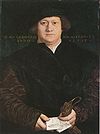
Herzog Anton Ulrich Museum
Encyclopedia

Braunschweig
Braunschweig , is a city of 247,400 people, located in the federal-state of Lower Saxony, Germany. It is located north of the Harz mountains at the farthest navigable point of the Oker river, which connects to the North Sea via the rivers Aller and Weser....
, Lower Saxony.
Founded in 1754, the Herzog Anton Ulrich Museum is one of the oldest museums in Europe. It houses a collection of masters of Western art, including Cranach
Lucas Cranach the Elder
Lucas Cranach the Elder , was a German Renaissance painter and printmaker in woodcut and engraving...
, Holbein, Van Dyck, Vermeer, Rubens, and Rembrandt. The museum is based on the Schloss Salzdahlum
Schloss Salzdahlum
Schloss Salzdahlum was a former summer palace built by Anthony Ulrich, Duke of Brunswick-Wolfenbüttel in 1684.It was dismantled in 1813 but parts of it can still be seen in the town of Salzdahlum....
art collection of Anthony Ulrich, Duke of Brunswick-Lüneburg (1633–1714), after whom it is named. In period catalogs, the term Bilder-Galerie zu Salzthalen refers to this collection.
The Copperplate Cabinet, with its over 100,000 pieces of print graphics and 10,000 drawings, is of great importance. There are also rotating exhibitions of art and craftwork from all over the world.
The present museum building was opened in 1887. Its architect, Oskar Sommer, planned the building in Italian Renaissance style. Currently, the museum is closed for renovations and is scheduled to reopen in 2014.

